Report – Peter Knego:
Peter Knego, a recognised ship historian, has very kindly given me express permission to reproduce his 14-page report here for all to read. This article, is a comprehensive walk through of the “Alferdoss” whilst laid up in Eleusis which was featured in a magazine titled ‘Voyage’ in 1996 ©. I apologise for the grainy images, these were screen grabs from Peters CD and was old technology in the early 90’s.

Please observe that this material including the photos used are copyrighted and all requests to use any portion for any reason should be directed to peter Knego direct. You can also purchase shipping CD roms, videos etc direct from Peter. My sincerest thanks goes to Peter for allowing me to share his report here.
Debris doesn’t obscure ALFERDOSS’s former Glory ©
As the once proud and beautiful former SS America lies crumbling under mountainous surf in a remote section of the Canary Islands, I reflect on my brief and only visit to her just two years ago. In 1992, after months of planning and anticipating, I finally found myself in the bay of Eluesis (just north of Pireaus) on a motor launch chugging it’s way to toward the ex – Atlantic greyhound.
It was a misty, yet sunny morning as the boat cut through the glass like water, passing clusters of fascinating laid up tonnage, ships built for different nations and purposes, some awaiting further service and some destined for the scraper’s torch.
The burnt-out Pegasus, the handsome little Orion, City of Mykonos and the sleek Argonaut together in a cluster with various cargo ships and ferries. Off in the far distance, I could see the former Windsor Castle tied together with a supertanker and the former Princippe Perfieto.
Across from them a mile or so lay the former Aureol, looking remarkably as she did in her Elder-Dempster U.K to East Africa days. Many other ships, great and small, lay in different clusters, the morning light reflecting off their tarnished hulls as our little boat churned onwards.
With my friend and fellow photographer, Mike Masino, our “crew” consisted of Samir (the former Americas watchman) and the owner of the motorboat (who seemed to demand 5,000 drachma for every turn the boat made!). Samir, affectionately dubbed the “Captain” of the ship (then named the Alferdoss, which is Arabic for “paradise”) was the most generous and helpful guide we could of asked for.
As we passed a cluster of ferries containing the former Black Watch (now known as the Crown M), the silhouette of the Alferdoss became visible for the first time. Rising majestically out of the mist, her blue hull streaked with a dozen years worth of rust and sediment, she awaited us like a great, forlorn monument. Fumbling with my cameras and video recorder, I was mesmerised by the sight of the forgotten, but beautiful old lady of the sea.
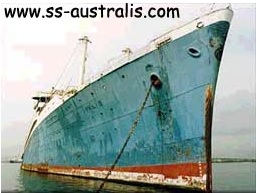
We circled her, starting from the stern, going along her port side where the murk above her waterline made it apparent that she spent sometime partially submerged. (Samir told us that one of her underwater bilge pipes rusted through, flooding the Engine room in the late 1980’s. She was ultimately beached and pumped dry.) Her aft funnel stood high and proud in faded blue topped with black, Its wonderful shape recalling her days as America (it’s pear shaped dome and square fin topping a circular band which surrounded the pear shape base. Her designer, Francis Gibbs, mimicked this on the United States funnels, but dispensed with the circular bands). The white “X’s” were visibly crumbling, the starboard one reduced to an obtuse “Y”. Her dummy forward funnel, sadly removed in her last incarnation for Chandris as the Italis in 1979 (rumour has it that it was severely corroded) was now just a stub where Italis was still propped up in large letters.
As we rounded her graceful, arched bow (which was riding rather high), and drew nearer , a huge flock of pigeons took flight from her upper decks, their years of residue having been caked into the liners superstructure by the unrelenting Greek sun.
Our boat pulled up to a rather dingy rope ladder, which Samir instantly scaled. He threw us a rope, which we threaded through our camera bags, and hauled up our precious cargo. As the boat bounced against the rusted hull, we scurried up the ladder (rust and peeling blue paint accompanying us) to the landing on A deck. Samir was busy unlocking her doors as we anticipated what lay in store for us.
The ships aft foyer, empty and closed, but relatively intact (save for its water-stained carpet) was the first enclosed space we saw. On the starboard bulkhead, a large deck plan and side view of the ship as Italis still in its display. A couple of metal leather-bound chairs lay askew, covered with dust.
Samir ushered us through a door directly across from the office area into the Atlantic Restaurant (her former tourist class dining room as the America). Wooden tables and metal chairs were strewn about haphazardly. A small amount of natural light came in from the portholes on either side, casting an eerie glare as I raced to photograph the room’s details.
In the dark centre, the small raised ceiling proudly carried those wonderful metal/bronze reliefs on each of its four walls: San Francisco, London, Paris, and the America herself sailing from New York. Water leakage from above had warped part of the ceiling and upper wall, but each work was perfectly preserved.
We moved forward through the immense galley, entering the gigantic Pacific Restaurant from the starboard aft. The quaint charm of the Atlantic restaurant was completely overshadowed by the scale and opulence of this wonderful room. All along it’s bulkheads were oriental looking gold leaf paintings from her days as the America.
Tan screens filtered in the sunlight from her portholes, some tattered and crumbling. We continued forward until we stood beneath the magnificent two deck high dome, our gaze moving from the powerful bronze-railed forward balcony along the columns on either side to the aft bulkhead, it’s two decks worth of golden art towering above us.
We worked our way quickly aft along her port side, taking in as much detail as we could. I asked Samir if we could see the ships indoor pool and then work our way back up to the cinema and disco.
Samir led us through the forward entrance of the Pacific restaurant to a pitch black lobby and down a flight of stairs, our flashlights revealing several interesting art deco wall pieces and a simple, yet classic, pattern in the linoleum flooring. From B deck, we crossed aft along her starboard companionway to a very small staircase that led us down to the pool area. It was tempting to look into some of the cabins we passed, but Samir urged us on, warning us to watch our step on the stairs and to avoid the oil stained walls.
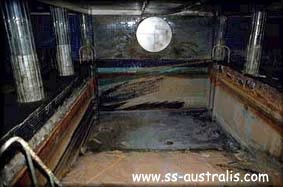
It soon became apparent that the ship had been flooded up through C deck as we arrived at the sadly deteriorated pool area. With all three of our flashlights illuminating part of the room, we noted the circular mirrors and painted dolphins on the aft tiled bulkhead, much crumbling blue tile surrounding the pool, the pools deep end still flooded with stagnant rust water. I stepped to the starboard side, heading toward the sauna, but feeling the deck slightly give way beneath my foot, immediately turned back (I did not want to end up in the engine room!). the gymnasium on the port side was covered with grime and oil as well.
Back up to B deck and forward again, we found her disco (a relatively unimpressive space which must have been added during her Australis days).
Small, oil stained red velvet stools lay strewn about the metal inlaid floor. In the corner was a red velvet-lined bar partially hidden by a metal trellis. On her starboard side, across from the disco was the cinema, it’s dusty seats haphazardly covered by sheets that offered little protection from the elements. A small, simple room, it, too, looked like an Australis edition. We peeked in at some outside cabins on this and were surprised to see them completely furnished save for linen and utensils. While some were repainted in strange pastel oranges and greens, most retained a great deal of the charm they must have had during America days.
The bathroom mirrors were wonderfully arched at the top and all fixtures were built solidly and made to last. The furniture was rounded and heavy in true late 30’s/early 40’s fashion. Samir led us up the main staircase, our flashlights catching the metal zodiac reliefs along it’s bulkheads, Capricorn, Taurus all except one (which looked like it had been removed recently by the outline left in it’s place).
Two decks up we headed aft through another foyer and onto the Pacific Restaurant forward balcony. Samir toyed with the piano, it’s notes echoing through the dome that once towered above the elite of the Atlantic. Samir took us to a suite, which had a bathtub, sitting room and several portholes. It’s sturdy, classic furniture and fittings were only slightly spoilt by some strange wallpaper, carpet and paint schemes. We looked in on some neighbouring cabins, hoping to find an old schedule or two and noted that every nightstand had a bible in or on it. Samir urged us to move on and save time for the best, which awaited us two decks above.
Working our way up the dark forward stairwell, we finally arrived at the Promenade deck level. Diffused sunlight filtered in through the port and starboard windows as Mike and I stood in awe, taking in the grandular of Alferdoss’s promenade foyer. To either side of us were alcoves that led out to the glass-enclosed promenades. In front of us was a set of thick bronze and glass doors, their ornate beauty clearly visible through the dust and film of 13 years.
Samir urged us on through these portals, and into the forward lounge, the smoking room. My eyes went directly to two colourful maps on the aft bulkheads of this circular room: on the port side, a map of the North Atlantic, and on the starboard side, a map of the South Atlantic. I had seen these in brochures from Australis emigrant days, blurting in my excitement to Samir, “I’ve waited twenty years to see this room”
I continued starboard along the maps, past the entrance to the library at the forward starboard section of the promenade and along the outer edge of the room. Stopping to switch cameras, I observed the stacked furniture on either side, partially covered by dusty white sheets. The faded gold and brown blinds along the windows were unravelling from their many years of neglect. I then moved forward until the windows curved, then ended at the midships bar. On the bulkhead behind the bar lay yet another map, this one of the Indian and South Pacific Oceans (in the same painting style as the two maps aft). The bar itself was semicircular and flanked by five leather stools to starboard. I had also seen this space in brochures, and marvelled that it still existed, faded yet intact.
Moving along to port, I passed more stacks of furniture (square faux rattan chairs), not necessary from the days of the United States Lines. There were however, permanently-affixed round tables that revealed their sturdy American heritage (I recalled seeing similar ones on the SS United States eight years earlier in Norfolk). Peering out the forward rusted windows, I sighed at the sorrowful state of the decks, pocked and scared by many years of the suns abuse and bird residue.
Now heading aft, I stopped to marvel at the smoking rooms greatest work of art, a huge circular bronze ceiling relief. Perhaps it represented the sun, as many finely detailed “rays” emanated from its edges, reaching out above the dance floor. A magnificent art deco relic, I can only wonder at it’s fate as the great ship lies crumbling in the Canaries.
Samir led us to the port gallery aft of the room (formerly known as the writing room), a rather unremarkable space, empty save for some fake wood shelving and cabinets added late in the ships life. A maritime treasure lay unravelled on one of these cabinets, however, one of the only souvenirs I was to obtain from my visit. A side elevation of the never-to-be -rebuilt Noga (her previous incarnation) and a huge detailed plan of her untouched promenade deck sat carelessly stained with coffee, awaiting rescue from oblivion. (Some ten years prior, architects gathered aboard the abandoned liner, making absurd yet ambitious plans to turn her into a floating resort off Beirut and then later, the west coast of Africa. Her “new” profile would include a glass dome over her stern, a helicopter pad, a raked funnel and other disturbing alterations. When this did not come to pass she was sold to Silver Moon Ferries, the owners at the time of my visit.
Samir rolled up the fading plans and escorted us through the gilded doors to the smoking room, and into the foyer. Facing aft this time we marvelled at the ceilings plaster fixture, shaped like an art deco cigar, leading aft past port and starboard wings, to another set of rich, massive bronze doors. When the ship was alive and lit, this particular space would of looked like a set in an irving Berlin musical.
Passing through these doors, we beheld the Alferdoss’s most magnificent space, the two deck high lounge, towering above us in its haunting majesty. Facing aft towards the great stage (still supporting a grand black piano), my eyes moved along the bronze railed balconies to either side, interspersed with great square columns. Even the edges of the ceiling in the lounge sported varying designs and textures.
(While the America was considered spartan and radically modern in contrast to the rococo European liners of pre-war days, she was still more lavish than her rather sterile and almost clinical big sister, the United States. However the United States made up for this in her engineering and technical achievements, far outclassing the America in size, speed, and ultimately, fame).
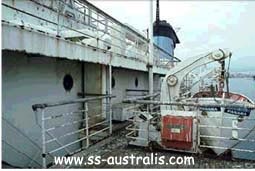
Panning my video camera behind me to the forward bulkhead that towered above the entrance, I was delighted to see the huge golden gesso relief of exotic birds from her America days. Save for a nick or two, the painting was largely intact, reminiscent of a fine Audubon illustration, highlighted with red, green and white accents. Gold wallpaper lined every bulkhead overall an unnecessary and relatively recent addition to the room. Missing were the plush sofas and cushioned chairs I had seen in the Australis brochures. In their place was more of that rattan type furniture seen in the smoking room, again haphazardly piled under yellowing sheets to either side of the great room. Exiting the lounge via its aft starboard doors, we entered a relatively simple, yet charming, wood paneled gallery, originally built as the card room, lastly used as the ships casino. Sparsely furnished, the rooms inboard bulkhead sported a smoked mirror and its ceiling had a white rectangular plane running it’s inboard length along with a line of smoked cylindrical glass lighting fixtures.
Passing through the rear of the room, we entered the cocktail bar. Some relatively unflattering red wall and blue ceiling paper could not diminish the impact of the eccentric original decor the room still boasted. The large recesses in the blue ceiling at point’s starboard, port and amidships were the settings for primitive paintings of life aboard the ship. Their detail was 100% intact, the primary coloured figures and scenes clearly visible in the misty brightness of the room. The large bar forward was a typical US lines, with curved wooden edges. Metal inlays sprung from the wood, no longer held within the confines of its graceful lines. Sturdy black metal and leather stools flanked the black base of the bar and the step that ran its length, their seats flanked with years of accumulated dust. Windows to either side room bowed outwards and looked out upon the ships promenades, their brass frames tarnished but still sturdy through all these years. Black leather sofas lined the aft and side bulkheads, accompanied by hardy rectangular metal and glass tables, again buried in dust.
Proceeding aft along the starboard side, we exited thick metal and glass doors into a rather spartan lobby, the ball room foyer, it’s more pleasing details revealed upon close scrutiny. By comparison with the elegant bronze doors in the forward promenade foyer, the four thick metal and glass doors (forward and aft, port and starboard) seemed austere. Nonetheless, they were attractive in their simple, functional design.
The aft bulkhead was flanked by what appeared to be a chrome map of the world, with landmasses raised half an inch or so above the seas. A stairwell continued up to the Sundeck in this space as we continued along our starboard trail to the room farthest aft on this deck, the ballroom.
Possibly the largest room on the promenade deck in square footage, the Ballroom lacked the grandeur of the lounge and the dramatic panorama of the smoking room. Regardless, it was highlighted by some extraordinary details, beginning with the large impressionistic painting by Charles Baskerville of a circus scene (replete with clowns, acrobats and animals in blues, reds and gray) on the forward bulkhead. Slightly recessed within a gold-pillared edging, this mural (which was installed in 1946) was well preserved and provided a dramatic, eerie backdrop to the dust-covered grand piano and the small, red carpeted stage at its base.
Samir called to me from the dance floor, insisting that I join him under the ballrooms architectural centrepiece: a large circular dome. From afar, I was puzzled by the unusual noises he was making, but when I got to him, I understood. In sort of an acoustic “warp”, the dome distorted and echoed all sounds made within one particular spot underneath it! One could distinguish nothing unusual-sounding, until standing in a four or five square foot area beneath this simple white dome, recessed not more than three or four feet into the ceiling. A close look at the faded and dusty maroon velvet chairs revealed more of Americas’s timeless heritage. Elegant, tarnished, brass-coloured frames supporting three upholstered sections, these chairs were a relic of a transatlantic “cocktail and big band” era, recalling images of the Rita Hayworth and John Garfield “cigarette – and – glamour” days.
Small round tables (bolted to the deck via metal cylindrical bases) revealed beautiful art deco concentric circular patterns beneath thick glass tops. From afar, they appeared to be mealy gray, dust covered tables.
Aft, to port and starboard, lay a few piles of deck furniture brought inside for protection from the intense Arcadian sun. The aft bulkhead was adorned with another, much larger circus-themed painting, broken up in the middle and framed on its sides with more gold pillar work. The red carpeting was dusty, stained and seemingly beyond repair. Again, as with nearly all the rooms on this deck, the sturdy bronze windows looked out onto the promenades.
Returning forward, we crossed through the port entrance to the ballroom, the ballroom foyer, the cocktail bar to a portside gallery known as the clubroom, complementing the starboard card room or casino space. The clubroom was of similar dimensions but had red velvet obscuring the wood paneling, lacked the smoked mirrors on its inboard bulkhead, and had no furnishings. We passed through the lounge and into the promenade foyer again, this time noting the simple figure-eight deco pattern emblazoned in its rubberised linoleum flooring and the heavy leather sofas placed in strategic spots along its bulkheads.
We ascended one level to Alferdoss’s Sun Deck, working our way aft via the starboard mezzanine balcony of the lounge. Offering a dramatic new perspective to the room’s double-deck grandular, we marveled at the detail in the thick brass railings and the intricate brass adornments that wrapped around the huge columns supporting the room. The light was brighter as it shone through windows looking out directly to the exposed Sun Deck as rather than the enclosed promenades of the deck below.
Off-white lamps in the booths along either side were awry, their shades in different stages of decay, and dirty beige curtains clung haphazardly to their supports. A close up look at the thick, peeling paint hanging from the aft corner of the rooms ceiling as well as an-over-the-shoulder glance toward that magnificent painting on the forward bulkhead were the last images we would have of this elegant salon.
Out through the aft doors, we made a turn toward the starboard Sun Deck for a look at the decaying majesty of the outer decks and wheelhouse.
Exiting the elegant lounge and into the harsh daylight, we paused to assess the bleak desolation of Alferdoss’s starboard Sun Deck. Stripped of all but her forward boats on either side, these decks like the rest of her exterior had been exposed to the full impact of the Greek sun and sea birds.
The railings were mangled and scarred by the removal of her davits. Her owner later explained that a scrap merchant had offered $2 million for the ship back in the late 1980’s. After accepting $1 million as a deposit a team of workers came aboard to begin dismantling. The boats and davits were removed and a bulldozer placed aft to begin the destruction when the scrap merchant defaulted on the balance. Her owner retained the ship, albeit without boats, but was now $1 million richer!
We walked forward along the splintered teak past the lonely boat with Italis still on its tattered bow, underneath the starboard bridge wing, and further along the open promenade until it began to circle the base of her forward superstructure. A rickety stairwell on the starboard side led us down to Promenade Deck level past a huge blistered cargo hatch (we were entering the Americas former third class deck space). The great Kingposts to port and starboard were lace in steel cables that must of been structurally compromised by their neglect. We continued down and forward past a smaller hatch on upper deck level. A bulkhead sheltered the aft section of this deck for passenger use. Clusters of dead weeds sprung from the ruined teak at the base of the severely corroded hold. We passed through an opening in the bulkhead leading to the forepeak. Faded ropes, coils of cable, chips of paint, capstans, and winches covered in bird residue presented an obstacle course as we worked our way to the tip of her bow.
Once there, the view aft toward the forward superstructure was majestic. Her bridge wings appeared to bow down and curve back in a aristocratic fashion. Such sleek, classical lines could not be obscured by this superficial disrepair.
Heading aft and up to the Sun Deck along her port side, we looked through the forward promenade windows and their tarnished panes at the smoking room for one last glimpse. The rusted railing gave way a little too much as we grasped it on the way up the port stairwell. After taking more shots facing aft along the port sun deck, we worked our way back around the starboard side and up to the officer’s promenade on sports deck.
On the aft section of the bridge wing sat a weathered vintage wooden deck chair, positioned with a view of Eleusis’s laid up ship clusters. I was shocked to find the huge sliding wooden door to the wheelhouse open, exposing it to the elements. We took shots from the end of the wing and worked our way past some canvas-wrapped navigation equipment to the wheelhouse.
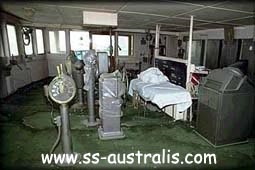
Aside from some water stained carpet and some food wrappers, the wheelhouse appeared unaltered from the ships active days. Her great metal wheel was attached to a cluster of instruments in the forward centre section of the room. Her present “captain” Samir, told us this was his favourite place to be in the late afternoon, perched in a comfortable chair, watching the sun go down over her bow.
After more photos, we peeked into the chart room, amazed at the library of books and charts that still lined its shelves. The base of her mast sprung from the forward part of this space and a skylight added a vintage charm to the ceiling.
I looked into the officer’s quarters just aft and starboard, which were cluttered with litter but otherwise preserved. After one more pass through the wheelhouse, past a pegboard showing the Italis last sailing schedule, we headed out to the port wing. I pushed the great wooden door all the way closed as we left, not wanting the elements to inflict any more damage to my beloved liner.
We were startled by Samir’s walkie-talkie, which crackled with a loud Greek voice. It was the boatman calling us to let us know he was on his way to get us – our two hours were up! When Samir saw the panicked look on my face, he asked me how much time we would need. Weighing that Samir had to return to work and Michael was still suffering from the aftermath of severe food poisoning, but knowing much more lay ahead, I asked for one more hour. “No problem,” Samir reassured, and told the man to return in one hour.
We climbed the stairs to the top of the wheelhouse for the ultimate view over her scorched, long, wide bow. Peering down over to the port wing, I could see the tarnished brass sign that said 186 feet to the bow and 537 feet to the stern. Another wheel and navigation station crowned the front section of this deck. Samir climbed her mast to the crow’s nest inviting us to do the same. We declined as our camera equipment and my fear of heights intervened, but in retrospect, I wish we had ………
The base of her dummy forward funnel sported Italis on its port and starboard flanks. A large whistle sat atop the peeling white structure, hints of blue paint revealing its former purpose. We worked our way aft through rafts, debris, ventilators, and pipes to her remaining funnel. The “Sampan” configuration was most intriguing from just below: pear shaped base, oval ring, and squared fin towering above us in scorched faded blue and black, pocked with rust. The “X” (Greek “C”) for Chandris looked withered and ready to come loose, the one to starboard already missing its lower aft quarter. We climbed further aft over more pipes and equipment down to her sports deck. The green painted deck was eroded and cracked, the faint white lines of deck tennis and shuffleboard courts still visible. Strangely the broken forward section of a lifeboat sat in the middle of the deck, resembling a lifeless beached mammal, how it got there and why will remain a mystery.
Before going down the port stairwell to Sun Deck level, I dashed quickly to shoot the starboard sheltered games deck spaces and rejoined Michael and Samir.
On the port aft sun deck, we looked forward along the plane where her lifeboats once were, past the rusted and torn railings, across the silent bay toward the dry, rugged mountains which had been the lonely liners backdrop for thirteen years.
We were just forward of the children’s playroom, near a rust stained, debris filled, blue paddling pool. A sign on the bulkhead read ” seven times around this deck equals one nautical mile”. Unfortunately, it never occurred to me to see the playroom. I understand it had some interesting original art, but since we only had another fifteen minutes left, we hurriedly moved down to the promenade deck.
Samir warned us not to use the railing to our right as we descended, demonstrating its weakness by tugging it back and forth. In this particular spot, a fall overboard would have dire consequences. How we managed not to get out onto the glass enclosed promenades until then escapes me.
Cameras drawn, we shot forward along the long corridor. Aside from some smashed windows in the aft section along both port and starboard sides, these decks were beautifully preserved. Small piles of deck chairs here and there were all that obscured these wonderful spaces. The rubber linoleum surface, brass framed windows and pipe lined ceiling were vintage America. After getting shots along her starboard side, I rejoined Mike and Samir as they continued aft.
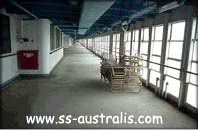
Past two kingposts and a small deckhouse containing the pool bar, I joined Mike as he stood by the severely corroded pool. Remains of a tattered net were draped across a pile of turquoise tiles that had fallen into the rusted metal shell. The decking in this area was ripped up and strewn about, and chunks of turquoise tiles were missing from the bar area, exposing plaster and rusted metal. Starboard and aft of the pool sat a yellow bulldozer, courtesy of the defunct scrapers. Even though the elements had not been kind to Alferdoss, this amount of damage could not of been organically caused. Another steering station replete wheel and covered navigation equipment sat just aft of the pool.
We moved further aft and down to upper deck and the very stern of Alferdoss. Here the railings also had been curiously smashed. We moved down to aft main deck to her docking equipment. Coils of red, brown and blue rope lay tangled amidst the capstans on the sheltered deck. This was one place her teak decking still looked good, having been sheltered from the baking sun.
Again the boatman radioed Samir – he was on his way. With still one more place for us to see, Samir urged us up and forward, along the desolate starboard sun deck to the captains cabin. The waiting room/office aside from some dust, looked ready to receive guests. A sign placed on a chair read ” SS ITALIS SAILS FOR BARCELONA 8 – 9- 79 @ 18:00 HOURS”. Wooden chairs with kelly-green upholstery, a black leather sofa, wooden cabinet and chrome light fixtures had served this space for many years. We stepped into the bedroom of the cabin, with it’s rich, polished wood paneling, oversized sofa, chairs with triangular arms and wonderful old wall fan. Aside from crumbling curtains, all was well here, too. I grabbed two sets of keys as souvenirs from a bowl of them on the dresser.
We could hear the gurgling of the boat below as we ran back along Alferdoss’s sun deck to the stairwell that would lead us down to the exit on aft A deck. It all seemed to go so fast as we piled into the boat and began chugging away. We were physically exhausted, emotionally elated, and spent of all film and battery power!
We headed back after a quick and expensive ride past the beautiful Latsis ships (Margarita L, Marianna VI, Marianna 9 – ex Windsor Castle, Aureol, and Principe Perifeito, respectively). After bidding our new friend Samir farewell, we went back to Athens for a rest. Had Mike felt better we might of taken Samir up on his offer to spend the night on the great ship, in retrospect, I deeply regret that we didn’t.
We spent the next day visiting the Achille Lauro (ironically another disaster waiting to happen) and Eluesis again to photograph the other laid up ships (another story in its self).
We circled Alferdoss as it began to rain, my last images of her in gray loneliness of the huge bay, awaiting her tragic fate.
That night we visited her owner, a kindly Arab gentleman, and his lovely wife. He was most curious as to why I came so far to see his ship. He told us he had been trying to avoid scrapping her but needed to sell her soon as he was moving to Canada in a couple of months.
At that time, a group in Montreal was contacting him about making the ship into a floating hotel on the St Lawrence. While she was in desperate need of cosmetic and mechanical repairs, she was remarkably well preserved inside. Had the tow to Thailand succeeded, I believe she would of served this role marvellously.
AFTERMATH:
Perhaps if she were scrapped, those beautiful murals, the quaint furniture, and the bronze fixtures would have been saved. An English gentleman, Steven Tacey, has visited the wreck twice. During the first visit in 1994, he found out she had been pillaged by the local Canary inhabitants for her precious wood. In his haunting photos, nearly all of the windows appear to have been smashed out. Her starboard promenade has been torched, and a hole is beginning to appear in the funnel. I have not yet heard the outcome of his July 1995 visit.
In the meantime, a Melbourne group proposes to refloat the two pieces and bring them to Melbourne on a giant barge to be patched together as the SS Australis floating hotel. Had this plan been attempted immediately after her grounding, it may have been remotely feasible.
The surf and wind in the Canary Islands will most probably claim the Alferdoss (now the American Star), before any person or group of persons. She is about to begin her third winter, helpless and broken, at the mercy of the great ocean she was built to cross. I cherish having had the honour of meeting this great lady in her twilight years and partaking of her abundant and unique beauty and character
Peter Knego
Retyped by Darren Byrne, with thanks to Peter Knego, January 1999, all photos and report © Peter Knego.
